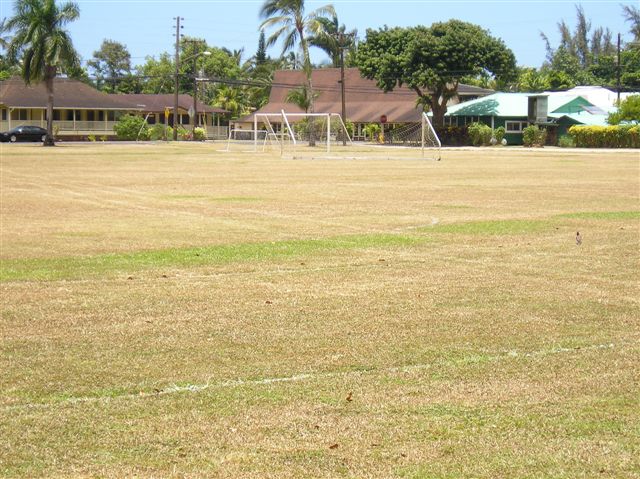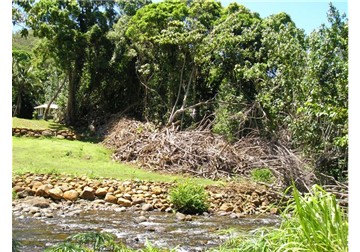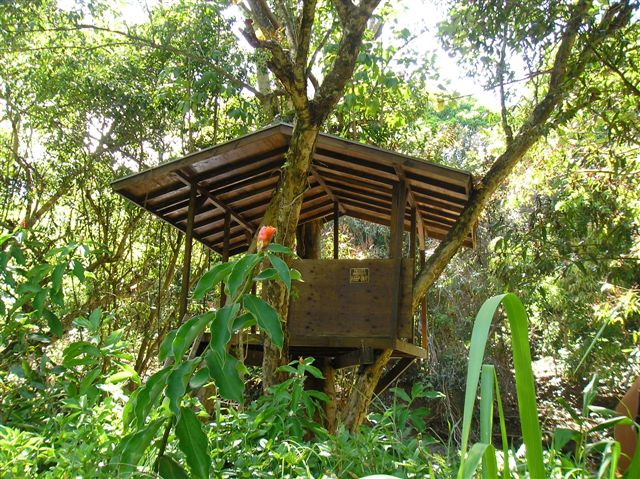|

By
Jacqueline Marcus
The days are warm and clear by the sea of Hanalei Bay, North Shore, Kauai.
To the average tourist, it’s nearly postcard perfect. However, beyond the
endless blue sky is a sad, heartbreaking story.
I’ve lived on this island for twenty-six years, painfully
aware of the drought conditions that are threatening the Hawaiian Islands
for the last four years. On the north shore of Kauai,
the
normal nightly rains have all but disappeared to a slight two-minute drizzle
once every two weeks compared to all night rains and light afternoon showers
during the spring and summer months.
Mindless of the
steady global warming trend, some may comment, "Well it's raining now," which
is similar to saying that the earth looks flat at the horizon and therefore
it must be flat."
In 2008, 99 percent
of the state was classified as experiencing "abnormally dry" conditions,
compared with 75 percent a year ago, according to the National Drought
Mitigation Center. And in April, typically one of the wettest months of the
year, nearly all the rain gauges on O'ahu got below-normal rainfall, with
more than half seeing 50 percent of normal.
The lack of rain is
especially worrisome on Maui and the Big Island, whose surface-level water
systems depend on the annual wet season for replenishment. Parts of the two
islands are so dry that the National Weather Service says they could soon
develop drought conditions. (1)
In 1988, we bought a narrow acre of land that runs parallel with the Wainiha
River (raging river). Wainiha River earned its name from its fierce
velocity of rushing rainwater that flows hundreds of feet down from the
rainiest mountain in the world: Mount Waialeale near the Na Pali summits.
Under normal rainfall conditions, the Wainiha River inhales and exhales like
luminous lungs for this lush botanical forest. The natural rain flow has an
intelligence of its own, sweeping stagnant debris from its banks, and
nourishing the diverse flora with its steady supply of pure rainwater.
There were always periodic flash floods, which kept the river and banks
perpetually clean.
Our land sits at the bottom of Kauai's remote Wainiha Valley. Fortunately,
the Nature Conservancy and Alexander & Baldwin preserved the Alakai
wilderness within Wainiha Valley, “the state's third-largest private nature
preserve. The 7,050-acre parcel of A&B land includes a summit region of
Mount Waialeale, one of the wettest areas on earth; Hinalele Falls; and
acres of rare, intact ecosystems in Wainiha Valley.
The rugged valley
and summit plateau are home to more than 100 plants that exist only in
Hawaii, 46 of which are only on the island of Kauai, and rare and endangered
Hawaiian forest birds, the 'akikiki, akeke'e, 'apapane, 'amahiki and 'elepaio.”
(2)
Global warming is
threatening the valley’s precious botanical regions, the wildlife and the
river’s ecological balance. The Wainiha River depends on perpetual rain or
else it – and everything in it – will die. The rainforest’s sensitive
flora and rich diversity of rare plants are turning brown and slowly
wilting.
A "density of rare
plants that occur only on Kauai that is remarkable," according to Trae
Menard, the Conservancy's Kauai program director, "If they are lost from
there, they are lost from the planet. In addition to its biological worth,
the preserve also is culturally important,” said Sam Gon III, a Conservancy
senior scientist and cultural adviser. The original "fragrant laua'e" fern
of many Kauai hula chants still thrives in Wainiha Valley.
Moreover, water
from Wainiha Valley powers the 101-year-old Wainiha Hydroelectric Plant,
which still supplies electricity on Kauai, and recharges several aquifers.”
(3)
On the west side of Kauai, the rivers have already vanished under the
relentless sun. As one woman reported in the local Kauai paper, “Rivers
became streams and then evaporated before my eyes. I watched fish gasp for
water until they died. There was nothing I could do. It was too sad to
watch…”(4)
In this photo, these bedrocks were always under water. During a typical
summer, the round, mossy boulders would occasionally emerge like wet
shimmering turtles in the sunlight, but then they’d just as quickly slip
under the rising water.

For some time now, the summits and valleys have been clearly visible; an odd
and also heartbreaking phenomenon for the reason that the Wainiha plateaus
were always shrouded with leis of clinging clouds. It was exceptional,
indeed, when the green summits appeared naked without their majestic robes
of mists and rainbows.
Everywhere you turned, rainbows, double rainbows, blessing the sea, crowning
the mountains and waterfalls, dozens of waterfalls, shimmering down the
cliffs like long silk ribbons, unfolding.
Not only have the rainbows vanished with the rain, as long as I can
remember, the Hanalei ball park grass was always a bright jade-green even
during the summer months. It’s mid-May and it’s entirely brown.

2.
This morning, I woke to the brutal sound of a bull-dozer. Humans are
responsible for global warming: the industrial age of oil and coal
pollution, clear-cutting vast forests and the “slash and burn” method of
clear-cutting instead of selective cutting are the largest contributing
factors to the production of the “greenhouse” effect that is melting
glaciers faster than scientists predicted and warming the temperatures of
the seas and earth to life-threatening degrees. As presented in Al Gore’s
Nobel Prize winning film, “An Inconvenient Truth”, we’ve been like sitting
frogs in a pot of warm water while the earth’s temperature has been
gradually rising.
Now we’re seeing the consequences of the industrial pollution era: severe
droughts, torrential and numerous hurricanes, tornadoes, earthquakes,
erupting volcanoes, including the Big Island’s Kilauea volcano that is
erupting as I write. The ash from these eruptions pollutes the air with its
particles of sulfur dioxide and natural gas and is a serious health risk to
humans and animals. Certainly natural disasters have always occurred but
not with such intensity and frequency as documented over the last eight
years. Although the causal evidence between man-made pollution and global
warming is categorical, it can still be quite abstract to most of us until
you’ve experienced the climate changes or abnormal weather disasters like
drought in a very real and personal way. And, as Gore pointed out, we
cannot ignore the looming fate of over-population.
Waking to the grinding noise of a bull-dozer, its gears shifting back and
forth, is an alarmingly offensive sound when you live in a silent emerald
forest like Wainiha. There are wild avocado, mango, apple-banana,
breadfruit and papaya trees to name only a few fruit-producing trees within
the valley. As seen by this picture, the owner of this one acre piece has
cleared the Hau, banyan, bamboo, guava, white ginger and vegetation that
compose a small, tropical forest. Now he has a “resort lawn” that requires
daily watering and maintenance. Instead of the birds’ melodic singing, I
hear and smell the fumes of a lawn mower. It’s unclear if he’s going to
leave the slaughtered debris or if he’s going to burn it, as most people do,
which pollutes the air for days.

If he wanted a house with a lawn, then why not buy a home in Princeville, a
suburb of homes, condos and resorts, or on flat land near Kilauea or on the
west Poipu side of the island where the desert-like landscape is enhanced by
more greenery? Blinded by his own ego, he plundered the tropical vegetation
for a barren lawn, which looks absurd in a rainforest. Like so many people
who move here, he has done his share of contributing to global warming with
his slash and burn mentality.
I’m reminded of the conversation between father and son in the film, “Lake
House” with Keanu Reeves and Sandra Bullock. Simon, the father, an
architect, shares his wisdom with Alex, his son, who is also an architect:
Simon: Do you remember visiting Casa de la Caritat?
Alex: The almshouse.
Simon: That's right. You mentioned Meier. His Barcelona museum stands in the
same area as Casa de la Caritat. It drinks the same light. Meier designed a
series of louvered skylights to capture that light and cast it inward to
illuminate the art within, but indirectly. And, that was important, because
although light enhances art, it can also degrade it. But, you know all that
already, you son of a gun. Now, this... where do you suppose this is to be
built?
Alex:
I have no idea.
Simon:
Oh, but you said you liked it.
Alex:
Conceptually.
Simon:
Now, come on. You know as well as I do that the light in Barcelona is quite
different from the light in Tokyo. And, the light in Tokyo is different from
that in Prague. A truly great structure, one that is meant to stand the
tests of time never disregards its environment. A serious architect
takes that into account. He knows that if he wants presence, he must consult
with nature. He must be captivated by the light. Always the light.
Always. (5)
3.
Mr. Lawn in his bull-dozer, clear-cutting the wild beauty of this lush,
botanical riverside, never once “consulted nature.” He never appreciated
the light gently falling through the twisted limbs of the Hau bush with
their dark orange foliage, or more importantly, how the Hau’s canopy of
leaves cool the river with its shade while the roots hold the soil intact at
the banks. He never smelled the sweet ginger blossoms after it rains. He
never listened to the cardinals, the Hawaiian pigeons cooing from the
branches or noticed that these trees are teeming with life: birds, geckoes,
frogs, butterflies and the entire diverse flora that depend on the
rainforest for its existence.
The couple who owned and sold the land across from us did the same thing. I
was shocked that the previous owners cleared the fruit trees that had been
there for hundreds of years! Papaya and sweet Apple-banana trees, Guava and
Lilikoi and even some of the ancient Mango trees, which was
unconscionable! But the new owners of the six acre land were equally
insensitive: they cut down several of the oldest Mango trees on the land for
a tree house that they rarely use. His neighbor asked why he cut the
beautiful Mango trees. He replied, “It obstructed my view of the
mountain.” It’s this sort of brainless arrogance that often leads to dire
consequences like the unnecessary invasion of Iraq. Minus the phony
excuses, if asked why, I imagine Bush’s reply would be: “Because I can.” It
also explains why Dante regarded pride as the worst sin of all. Moreover, he
conveniently sliced the trees in half for the foundation instead of allowing
the trees to support it.
Contrary to “obstacles of the mountain,” in this photo, this tree house is
supported by an Azalea and two plum trees, like a lovely temple, the trees
are a supporting foundation much like the children’s story The Giving
Tree. Sadly, we know what happened at the end of that story—but cutting
down trees won’t ever happen on our land.

Aesthetically speaking, those who do consult nature by respecting the
tropical habitat, have the most beautiful homes. They conserve on energy by
leaving the trees for shade which reduces the sun’s heat significantly in
the tropics. Also, a rainforest is low maintenance if left in its natural
state. And with a little management, plants and trees provide a wall of
privacy, a precious commodity on these small islands where space is limited
and at times, over-crowded. For example, consider the familiar Hawaiian
homes that are pleasing to the eye because they blend in with nature
compared to this concrete monstrosity in the middle of a tropical
rainforest.

4.
Contrary to the attitude of prideful arrogance, Wendell Berry aptly
expressed the cautionary warning of respecting nature’s boundaries in his
poem, “Some Further Words”:
Let me be plain with you, dear reader.
I am an old-fashioned man. I like
the world of nature despite its mortal
dangers. I like the domestic world
of humans, so long as it pays its debts
to the natural world, and keeps its bounds…
He elaborated on this urgent theme of honoring limits in his Harper’s
essay “Faustian Economics / Hell hath no limits” (May issue 2008).
The entire earth could go up in flames and the same corrupt politicians
would still have their greedy hands out for more pay-offs even if it
means sacrificing our present-future as we know it. They just don’t get
it: No matter how many millions of dollars are taken in briberies, money is
worthless without water and clean air.
5.
What I miss most about the intermittent rains is the way the leaves, stones,
grass and even the roads glistened like shimmering pearls under a wet sun.
After the rains, you could smell the sweet scent of plumeria and ginger
flowers. Now the leaves droop in a dusty gloom of dullness from lack of
rain. It’s as if the prana (life-force) has evaporated, sapping the
vitality from its source...
Time is running out. As Kevin Baker
put it his Harper's essay, "The trouble is that we are at one of
those rare moments in history when the radical becomes pragmatic, when
deliberation and compromise foster disaster. The question is not what
can be done but what must be done." (Barack Hoover Obama: The best
and the brightest blow it again; Harper's; June 2009).
With a Corporate Supreme Court that has recently rejected five critically
urgent environmental cases in favor of big business,
(Environment
Groups Find Less Support From Justices
Environmental groups lost all five
of their cases before the Supreme Court last term, a trend scholars see
continuing as the court moves to the right.
New York Times; 7-4-09),
President Obama must do what Bush/Cheney did with executive orders: Bush
radically delivered for his industrial polluting friends and then flipped
the finger at those who objected. Now it's President Obama's turn to
establish the necessary, regulatory laws-changes for protecting the
environment because our welfare, our health, our very existence depends
on action NOW. How we would all love for President Obama to
flip his finger at Exxon, for instance. It would represent
millions of middle fingers around the world at the few, old, white, male,
industrial tyrants (oil, defense, coal, drugs) that have been
systematically hording
most of the wealth and
destroying our planet for the last hundred years.
As I've tried to point out, it's not only
corporate developers and politicians that are ignoring the current threat of
global warming, we must change our selfish 1940 attitudes of doing what we
please, burning and slashing in tropical forests for lawns contributes to
global warming and the demise of these islands. Pulitzer Prize winning poet, W.S. Merwin, a resident of Maui, expressed this message in his poem, "Rain
at Night".
Rain at Night
This is what I have heard
at last the wind in December
lashing the old trees with rain
unseen rain racing along the tiles
under the moon
wind rising and falling
wind with many clouds
trees in the night wind
after an age of leaves and feathers
someone dead
thought of this mountain as money
and cut the trees
that were here in the wind
in the rain at night
it is hard to say it
but they cut the sacred 'ohias then
the sacred koas then
the sandalwood and the halas
holding aloft their green fires
and somebody dead turned cattle loose
among the stumps until killing time
but the trees have risen one more time
and the night wind makes them sound
like the sea that is yet unknown
the black clouds race over the moon
the rain is falling on the last place
--W.S. Merwin, The Rain in the Trees

Sources:
1-4: (Star Bulletin, “Saving the Valley”)
http://starbulletin.com/2007/11/21/news/story04.html)
5. Quote from the film “Lake House”
6. “Some Further Words”;
Berry, Wendell. "Some Further
Words." Best American Poetry 2003. NY: Scribner, 2003, p. 28-32.
Additional Sources:
Hawaiian Islands Sensitive ecosystem
Drought stats articles:
http://hawaii.gov/dlnr/cwrm/drought/index.htm
http://the.honoluluadvertiser.com/article/2003/Aug/13/ln/ln04a.html
(global warming)
http://www.honoluluadvertiser.com/apps/pbcs.dll/article?AID=/20080527/NEWS12/805270352/1001
http://www.huffingtonpost.com/2009/03/21/all-hawaiian-birds-at-ris_n_177691.html
Nearly All Native Hawaiian Birds At Risk Of Extinction:
Report
Jacqueline Marcus’
poems have appeared in The Kenyon Review, The Ohio
Review, The Antioch Review, The Journal, The Wallace Stevens Journal, The
Literary Review, Mid-American Review, Poetry International, Hotel Amerika,
The Delta Review, The American Poetry Journal and more. Her book of poems,
Close to the Shore, was published by Michigan State University
Press. Her political essays have been published at CommonDreams.org
and BuzzFlash.com. She taught philosophy at Cuesta College, San Luis
Obispo, California, and is the editor of
http://www.ForPoetry.com.
She is currently promoting green technologies (solar & wind) on the island
of Maui.
www.GoSolarMaui.com
Contact:
solar@GoSolarMaui.com
|
![]()